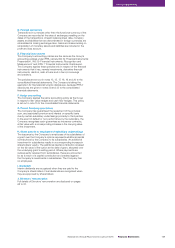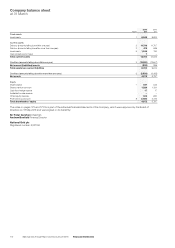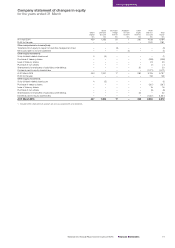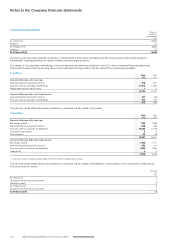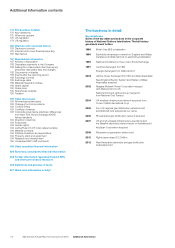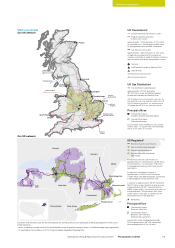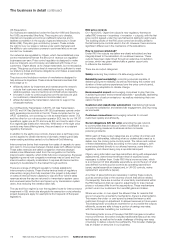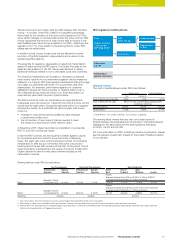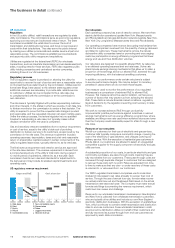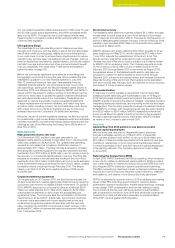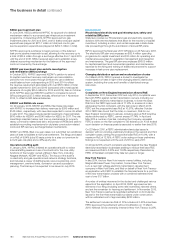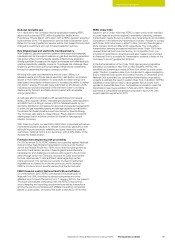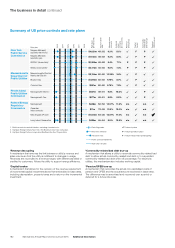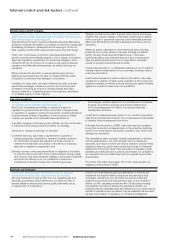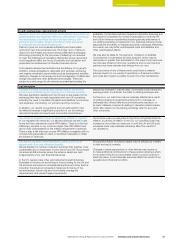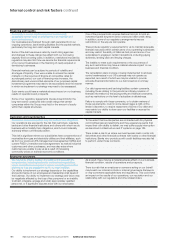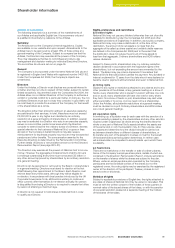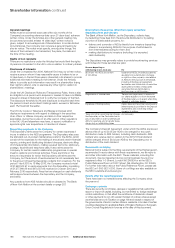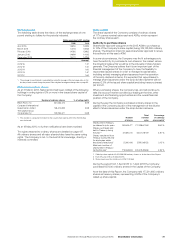National Grid 2016 Annual Report Download - page 181
Download and view the complete annual report
Please find page 181 of the 2016 National Grid annual report below. You can navigate through the pages in the report by either clicking on the pages listed below, or by using the keyword search tool below to find specific information within the annual report.
Our Long Island generation plants sell capacity to LIPA under 15-year
and 25-year power supply agreements, and within wholesale tariffs
approved by FERC. Through the use of cost based formula rates,
these long-term contracts provide a similar economic effect to cost
of service rate regulation.
US regulatory filings
The objectives of our rate case filings are to make sure we have
the right cost of service, with the ability to earn a fair and reasonable
rate of return while providing safe, reliable and economical service
to our customers. In order to achieve these objectives and to reduce
regulatory lag, we have been requesting structural changes, such as
revenue decoupling mechanisms, capital trackers, commodity-related
bad debt true-ups and pension and other post-employment benefit
true-ups, separately from base rates. These terms are explained
below the table on page 182.
Below, we summarise significant developments in rate filings and
the regulatory environment during the year. We completed the final
stabilisation upgrade to our new financial systems in July 2014.
With 12 months of historical ‘test year’ data available from the
stabilised financial systems, we commenced a new round of full
rate case filings, starting with the filing for Massachusetts Electric in
November 2015, and followed by the filings for KEDNY and KEDLI in
January 2016. We expect to make a number of such filings over the
next two to three years to update the capital investment allowances
and rate bases across many of our businesses. These filings are
expected to capture the benefit of recent increased investments
in asset replacement and network reliability, and reflect long-term
growth in costs, including property tax and healthcare costs. Along
with a clear focus on productivity, the filings are key to improving
achieved returns in the Company’s US distribution activities.
Moreover, as part of current regulatory initiatives, we filed a proposal
for investments in grid modernisation in Massachusetts and anticipate
a similar proposal for innovative technology deployments and service
offerings as part of the Reforming the Energy Vision (REV) effort in
New York in 2016.
Massachusetts
Massachusetts electric rate case
On 6 November 2015, we filed a one-year rate plan for our
Massachusetts electric business to take effect from 1 October 2016,
which was updated on 29 April 2016. The updated rate case filing
requests an annualised net increase in distribution revenue of
approximately $137 million. The filing includes a request to increase
annual capital investment subject to the capital investment recovery
mechanism from $170 million to $285 million, and to include property
tax recovery on incremental capital placed in service. The filing also
requests an increase in annual base rate funding of the storm fund
mechanism from $4.3 million to $14 million, and a 14-month extension
of the incremental funding to address the storm fund’s deficit, created
by weather events occurring through February 2015. The filing is
based on an RoE of 10.5% and a capital structure of 52% equity
and 48% debt.
Capital investment programmes
On the gas side, on 30 October 2015, we filed the second plan in a
20-year programme to replace ageing gas infrastructure by receiving
concurrent cost recovery for eligible capital investments. On 29 April
2016, MADPU approved our proposal to place an additional $28.9
million into rates effective from 1 May 2016, related to $219 million
of anticipated investments in 2016 under this accelerated pipe
replacement plan. The Company filed the reconciliation of the 2015
investments on 29 April 2016. Additionally, the Company continues
to recover costs associated with its pre-existing leak prone pipe
replacement programme outside of base rates until the next rate
case, including the submittal of a proposal to begin recovery of an
additional $4.1 million of incremental revenue requirement effective
from 1 November 2016.
Storm fund recovery
The Massachusetts electricity business collects $4.3 million annually
in base rates to credit towards a storm fund devoted to fund major
storm response and restoration efforts. The severity and frequency of
storms in Massachusetts between February 2010 and February 2016
resulted in approximately $252 million of incremental storm-related
costs as at 31 March 2016.
MADPU allowed us to begin collecting $40 million annually for three
years beginning on 4 May 2013, and an additional $7.6 million from
1 July 2014, towards the replenishment of the storm fund. This
annual recovery was further extended through 4 August 2016.
Ultimate recovery of the storm costs is subject to a prudency review
by MADPU of the underlying costs. The Company expects an order
on the prudency of $213 million of storm-related costs from the
February 2010 through March 2013 storm events by August 2016.
As explained above, in the Massachusetts electric rate case, we
proposed to collect the deficit created by storm events through
February 2015, subject to a prudency review, and increase the annual
base rate funding of the storm fund. Recoverable costs associated
with storm events after February 2015 are deferred for future recovery
and subject to future prudency review.
Grid modernisation
In response to a 2014 regulatory requirement, the Company filed
a Massachusetts electricity grid modernisation plan on 19 August
2015 that proposed multiple investment options that would further
MADPU’s goals of reducing the effect of outages, optimising demand,
integrating distributed resources, and improving workforce and asset
management. The Company presented a range of investment options
for MADPU to consider, with investment levels over five years ranging
from $225 million to $831 million. MADPU established criteria that,
if met, would allow the capital costs from the plan to be recovered
through a separate capital recovery mechanism. MADPU initiated
its review of the Company’s plan in April 2016.
New York
Upstate New York 2015 petition to use deferred credits
to fund capital expenditures
With the three-year rate plan for Niagara Mohawk’s electricity
and gas businesses expiring on 31 March 2016, in December
2015, we filed a petition with NYPSC to use up to $124 million and
$27 million of deferred credits associated with its electricity and gas
operations, respectively, to fund incremental capital expenditures
for those businesses in 2017 and 2018 above the capital allowances
in the expiring rate plan. The Company expects an order in May
or June 2016.
Reforming the Energy Vision (REV)
In April 2014, NYPSC instituted the REV proceeding, which envisions
a new role for utilities as distributed system platform (DSP) providers
who create markets for distributed energy resources (DER) and more
fully integrate DER in distribution system operations and planning.
The REV proceeding’s objectives include: enhanced customer energy
choices and control; improved electricity system efficiency, reliability,
and resiliency; and cleaner, more diverse electricity generation.
NYPSC is expected to issue an order in 2016 to address rate-making
issues under REV, including opportunities for outcome-based
shareholder incentive mechanisms, market-based earnings, changes
to rate design, DER compensation and the rate-making process.
The Company’s first five-year distributed system implementation
plan is expected to be filed in June 2016 and will identify incremental
investments in utility infrastructure necessary for implementation
of the DSP role and greater DER integration.
Additional Information
179National Grid Annual Report and Accounts 2015/16 The business in detail


